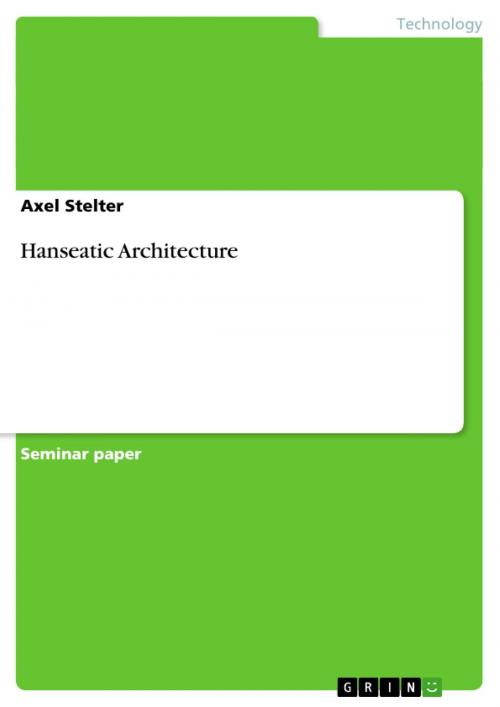| Author: | Axel Stelter | ISBN: | 9783640241101 |
| Publisher: | GRIN Publishing | Publication: | January 12, 2009 |
| Imprint: | GRIN Publishing | Language: | English |
| Author: | Axel Stelter |
| ISBN: | 9783640241101 |
| Publisher: | GRIN Publishing |
| Publication: | January 12, 2009 |
| Imprint: | GRIN Publishing |
| Language: | English |
Seminar paper from the year 2008 in the subject Engineering - Civil Engineering, grade: A, University of California, Berkeley , 15 entries in the bibliography, language: English, abstract: In 1894 the British architect John Tavenor wrote an article about the remains of medieval architecture in the Baltic area. He concluded that the style in this area has been carried throughout the Middle Ages and further stated that the style is 'quite dissimilar to those of the rest of the continent' , meaning the Gothic style, that started to spread over Europe in the 11th and 12th centuries. He calls this architecture the 'Baltic style' and considers it to be a sub-style of the Gothic style. The Holy Roman Empire, which contributed to the spread of the Gothic style, only reached as far as the Elbe River in Germany. The Baltic area, as the heart of Northern Europe, was fractured into many kingdoms, principalities and lordships in the 1st millennium B.C. So how was it possible that cultural and economic goods could spread in these disadvantageous circumstances, at a time when 'commerce by sea was little more than outrageous piracy and commerce by land was obliged to follow one or two beaten tracks across Europe in order to escape merciless exactions of the robber barons' ? One answer could be the Hanseatic League, a protected network created by merchants, in order to protect their trade. This alliance allowed trading guilds to manifest a trade monopoly within the entire Baltic area. Since the League was not tied to any sphere of control but the merchants themselves, trades could be made easily within Northern Europe. Consequently the simultaneous appearance of the League and the Baltic style suggest that there is a possible correlation between the architecture in the Baltic area and its spread along the Hanseatic League's trading routes. During this essay I am going to support this assumption by finding exemplifying similarities among buildings in the Hanse towns along the main trading routes. [...]
Seminar paper from the year 2008 in the subject Engineering - Civil Engineering, grade: A, University of California, Berkeley , 15 entries in the bibliography, language: English, abstract: In 1894 the British architect John Tavenor wrote an article about the remains of medieval architecture in the Baltic area. He concluded that the style in this area has been carried throughout the Middle Ages and further stated that the style is 'quite dissimilar to those of the rest of the continent' , meaning the Gothic style, that started to spread over Europe in the 11th and 12th centuries. He calls this architecture the 'Baltic style' and considers it to be a sub-style of the Gothic style. The Holy Roman Empire, which contributed to the spread of the Gothic style, only reached as far as the Elbe River in Germany. The Baltic area, as the heart of Northern Europe, was fractured into many kingdoms, principalities and lordships in the 1st millennium B.C. So how was it possible that cultural and economic goods could spread in these disadvantageous circumstances, at a time when 'commerce by sea was little more than outrageous piracy and commerce by land was obliged to follow one or two beaten tracks across Europe in order to escape merciless exactions of the robber barons' ? One answer could be the Hanseatic League, a protected network created by merchants, in order to protect their trade. This alliance allowed trading guilds to manifest a trade monopoly within the entire Baltic area. Since the League was not tied to any sphere of control but the merchants themselves, trades could be made easily within Northern Europe. Consequently the simultaneous appearance of the League and the Baltic style suggest that there is a possible correlation between the architecture in the Baltic area and its spread along the Hanseatic League's trading routes. During this essay I am going to support this assumption by finding exemplifying similarities among buildings in the Hanse towns along the main trading routes. [...]















